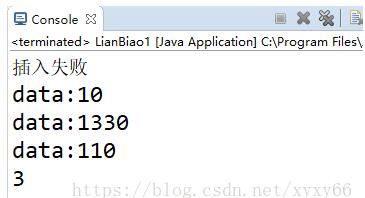Java 实现链表结点插入
PS:链表是一种数据结构,而数据结构就是一种存放数据的方式。
为什么需要链表?
我们知道,数组也可以存储数据,那么为什么还需要链表呢?接下来,我们来看看数组 和链表的区别:
1、数组就像身上编了号站成一排的人,要找第10个人很容易,根据人身上的编号很快就能找到。但插入、删除慢,要往某个位置插入或删除一个人时,后面的人身上的编号都要变。当然,加入或删除的人始终末尾的也快。
2、链表就像手牵着手站成一圈的人,要找第10个人不容易,必须从第一个人一个个数过去。但插入、删除快。插入时只要解开两个人的手,并重新牵上新加进来的人的手就可以。删除一样的道理。
链表示意图

链表的建立
class TestLink{//创建一个外部类
private Entry head;//指向头结点的引用
public TestLink(){
head = new Entry();//用结点类 new 一个头结点
}
class Entry{//Entry 创建一个结点内部类
int data;//定义数据块
Entry next;//定义地址块
public Entry(){//构造方法1
data = -1;//对结点数据块初始化
next = null;//对地址初始化
}
public Entry(int val){//构造方法2
data = val;//对数据块赋值
next = null;
}
}
}
public class TestDemo2 {
public static void main(String[] args) {
TestLink testlink = new TestLink();
//创建一个 链表外部类 对象
}
}
头插法:从头插入
public void insertHead(int val){
//有这么一个结点
Entry cur = new Entry(val);
cur.next = head.next;
head.next = cur;
}
头插法示意图:

尾插法:从尾插入
public void insertTail(int val){
//找到尾巴
Entry cur = head;
while(cur.next != null){//遍历结点
cur = cur.next;
}
Entry entry = new Entry(val);//得到的结点
cur.next = entry;
}
尾插法示意图:

从任意结点插入
public boolean insertPos(int val,int pos){
//1、判断pos的合法性
if(pos < 0 || pos >= getLength()+1){
return false;
}
Entry cur = head;
for(int i = 0;i <= pos-1;i++){
cur = cur.next;
}
//cur pos的前一个
Entry entry = new Entry(val);
entry.next = cur.next;
cur.next = entry;
return true;
}
示意图:

完整代码:
package LianBiao;
class TestLink1{
private Entry head;//指向头结点的引用
public TestLink1(){
head = new Entry();
}
class Entry{//Entry Node
int data;
Entry next;
public Entry(){
data = -1;
next = null;
}
public Entry(int val){
data = val;
next = null;
}
}
public void insertHead(int val){
//有这么一个结点
Entry cur = new Entry(val);
cur.next = head.next;
head.next = cur;
/*head.next = cur;
cur.next = head.next;*/
}
public void insertTail(int val){
//找到尾巴
Entry cur = head;
while(cur.next != null){
cur = cur.next;
}
Entry entry = new Entry(val);//得到的结点
cur.next = entry;
}
//得到单链表的长度:
public int getLength(){
int len = 0;
Entry cur = head.next;
while(cur != null){
len++;
cur = cur.next;
}
return len;
}
//将数据插入到指定位置
public boolean insertPos(int val,int pos){
//1、判断pos的合法性
if(pos < 0 || pos >= getLength()+1){
return false;
}
Entry cur = head;
for(int i = 0;i <= pos-1;i++){
cur = cur.next;
}
//cur pos的前一个
Entry entry = new Entry(val);
entry.next = cur.next;
cur.next = entry;
return true;
}
//
//show()
public void show(){
/*Entry cur = head;
while(cur.next != null){
System.out.println("data:"+cur.next.data);
cur = cur.next;
}*/
Entry cur = head.next;
while(cur != null){
System.out.println("data:"+cur.data);
cur = cur.next;
}
}
}
public class LianBiao1 {
public static void main(String[] args) {
// TODO Auto-generated method stub
TestLink1 testlink = new TestLink1();
testlink.insertTail(1330);
testlink.insertTail(110);
//1330 110
testlink.insertPos(10,0);
//10 1330 110
if(testlink.insertPos(32,10000)){
System.out.println("插入成功");
}else{
System.out.println("插入失败");
}
//10 32 1330 110
testlink.show();
System.out.println(testlink.getLength());
}
}
输出结果:

补充:java中创建链表,实现链表的尾部插入
我就废话不多说了,大家还是直接看代码吧~
package test;
//目标:创建链表,实现链表结点的尾部插入
class Node_5{
private String data;
public Node_5 nextNode;
public void setData(String indata){
this.data=indata;
}
public String getData(){
return this.data;
}
public void setNextNode(Node_5 newNode){
this.nextNode=newNode;
}
public Node_5 getNextNode(){
return this.nextNode;
}
public void addData(String indata){
setData(indata);
Node_5 node_5=new Node_5();
Node_5 head=node_5;
if(node_5.getData()==null){
node_5.setData(indata);
System.out.println(node_5.getData());
}
else{
node_5.setNextNode(node_5);
node_5.setData(indata);
System.out.println(node_5.getData());
}
}
}
public class T_5 {
public static void main(String[] args) {
// TODO Auto-generated method stub
Node_5 node_5=new Node_5();
for(int i=1;i<=3;i++){
node_5.addData("第"+i+"结点");
}
}
}
以上为个人经验,希望能给大家一个参考,也希望大家多多支持我们。如有错误或未考虑完全的地方,望不吝赐教。
赞 (0)

